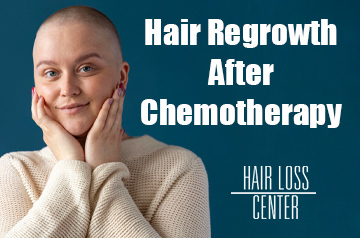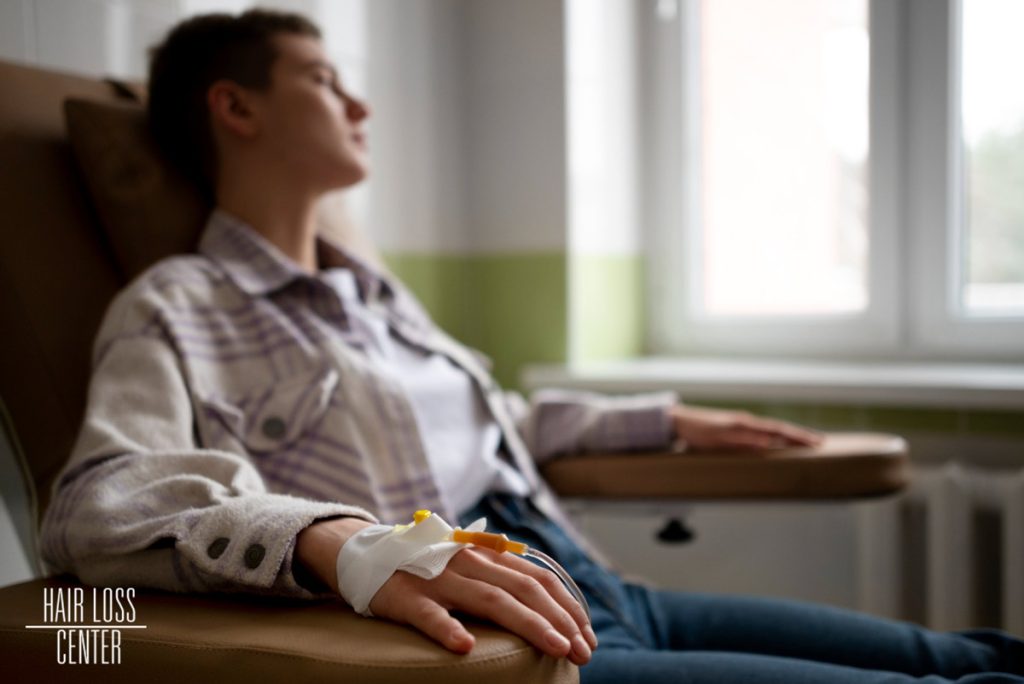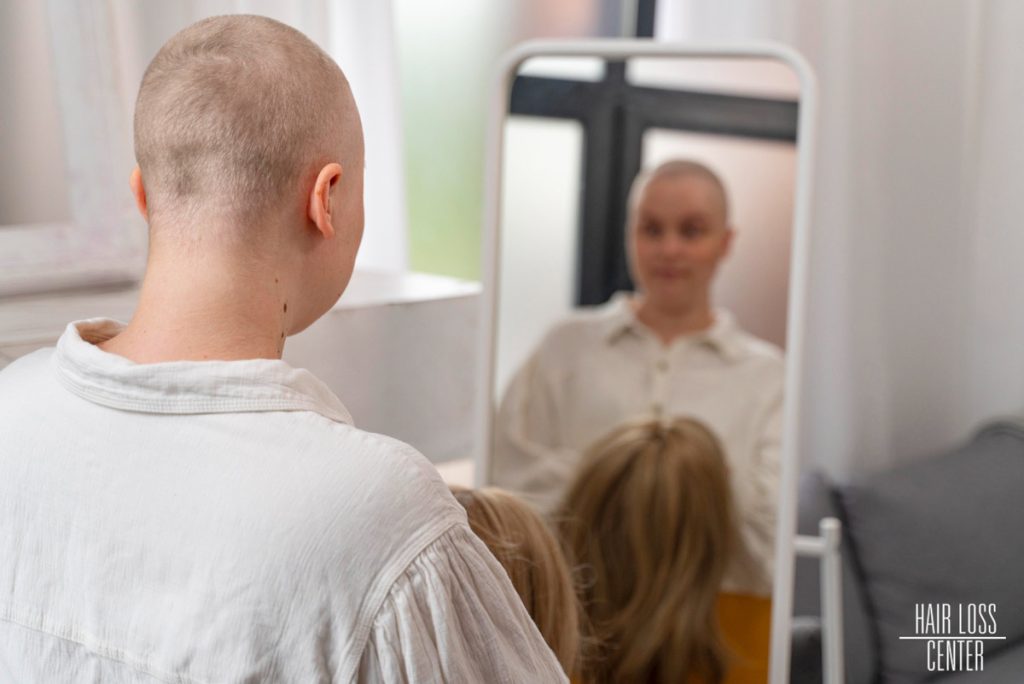

Hair Regrowth After Chemotherapy; Useful Tips and Insights
Chemotherapy is a big battle to go through and hair loss can be a constant reminder of this challenge. These days, wearing a realistic human hair wig is helping many chemo patients to stay positive and confident, however, to see hair regrowth after chemotherapy is one of the most rewarding milestones in the process of recovery.
Hair after chemo may not be the same hair you used to have and you should know how to take care of it and enhance its regrowth. Besides, learning about this process helps you know what to expect and stay hopeful and calm as you recover.
So, we’re going to discuss everything you should know about hair regrowth post-chemo and provide some tips for better and faster hair recovery.
Find top-quality medical human hair wigs at Newport Hair Loss Centers in Southern California. Call now to schedule your free consultation session.
How Does Chemotherapy Affect Our Hair?
Simply put, chemotherapy drugs target rapidly dividing cells in the body because rapid cell division is a characteristic of cancerous cells. However, our normal hair follicles also have this characteristic to produce new hair.
As a result, the drugs also disrupt the hair growth cycle and cause significant hair loss over a relatively short time.
Hair loss usually starts within two to four weeks after starting chemotherapy but its rate and extent aren’t the same for every patient. Depending on the factors below, some may experience hair thinning while others lose all their hair, even eyebrows, eyelashes, facial hair, and body hair.
- Type of the chemotherapy drug and its dosage
- Genetics
- Patient’s overall health, diet, and some other individual factors
Chemo hair loss is one of the visible side effects of chemotherapy and it affects the appearance of the patient a lot. That’s why it’s considered the most emotionally challenging side effect. Also, it might lead to uncomfortable conversations because everyone can notice it easily.
A good temporary solution for those cancer patients who wish to look more like they used to and have their privacy is to wear a comfortable cancer wig. Plus, a medical wig protects the sensitive scalp.
Fortunately, for most patients, the hair starts to grow back after the treatment ends.
Everything You Should Know About Hair Regrowth After Chemotherapy
A few weeks after chemotherapy ends, hair regrowth starts. However, it doesn’t look very much like your normal hair at the beginning and it takes time to return to normalcy. There might also be some permanent changes to its quality.
In the sections below, we’ll discuss what to expect and how you can enhance the process.
How Fast Is Hair Regrowth After Chemotherapy?
The hair on the scalp starts to regrow within 3 to 6 weeks after the completion of treatment. Then, eyebrows, eyelashes, and other body hair start to grow back.
The pace of hair growth isn’t that much different from before chemotherapy and is usually about half an inch per month.
How Is Hair Quality Different from Patient’s Normal Hair Before Chemotherapy?
At least for the first 6 to 12 months, the quality of the new hair is significantly different from the patient’s normal hair. Here are some differences you should expect after chemotherapy.
Changes in Hair Texture
You may have heard the term ‘chemo curls’ that refers to hair being curlier and wavier than it used to be. So, this is a common change in hair texture that many patients experience after chemotherapy.
In addition, the new strands might be softer and finer than before, or coarse and thicker than before.
Hair Color Changes
There can be temporary changes in hair color. For example, many patients notice an increase in gray and white hair compared to before. In some cases, the shade may appear darker or lighter than before.
These changes usually revert gradually.
Changes in Density and Thickness
The hair doesn’t grow fully back quickly. At first, it’s thin and patchy but it gets thicker gradually.
For some patients, especially those who have gone through extensive chemotherapy, the hair may never return to its previous thickness.
Fragility and Increased Shedding
The scalp is sensitive and the new hair is brittle and fragile. This means that they should be handled gently and carefully. So, avoid harsh treatments, like coloring, and only use gentle products during this time.
Also, some patients experience increased hair shedding during the first few weeks of hair regrowth, but it usually decreases over time as the follicles recover.
Overall, the experience of hair regrowth after chemotherapy is different for every patient but all of them notice changes in the quality of their hair. Most of these changes revert within 6 to 12 months but some of them may be permanent.
Factors Affecting Hair Regrowth After Chemotherapy

Learning about the factors that affect the quality and timing of hair regrowth after chemotherapy can help patients approach this process with greater calm and confidence. Plus, they can actively manage some of these factors to achieve better results.
– Type, Dosage, and Duration of Chemotherapy
Chemotherapy drugs are varied and some of them, like doxorubicin, cyclophosphamide, and paclitaxel, have a strong impact on hair follicles leading to more extensive hair loss and delay in hair regrowth.
Additionally, higher doses and longer treatments cause more hair loss and take longer to recover from.
– Patient’s Health Factors
A patient’s overall health, like a healthy immune system and lack of other medical conditions, plays an important role in experiencing a quicker recovery and hair regrowth.
What’s more, younger patients usually experience faster, better, and more robust hair regrowth than older ones.
– Genetics
Hair type, color, and natural growth cycle are influenced by our genes. So, people with genetic predispositions to hair loss or curly hair may experience these changes more than others. For example, in some patients, the follicles recover from the disrupted hair growth cycle more slowly than others.
– Post-Chemo Care and Hair Treatment
Scalp becomes sensitive during and after chemotherapy and patients need to take care of it by protecting it from harsh chemicals and sun exposure.
Another important factor is diet. The patient’s body needs vitamins and minerals that are necessary for hair regrowth more than ever.
These two factors (scalp care and nutritional support) influence the quality and speed of hair regrowth after chemotherapy.
Some patients may choose to try hair growth treatments, such as topical options like minoxidil or laser therapy (like LLLT). However, none of these hair growth treatments should be pursued without a recommendation from your healthcare professional.
– Psychological Factors
Dealing with cancer and its treatment can be stressful but high levels of stress can negatively affect the regrowth process. So, stress management and overall emotional well-being are essential to improve hair regrowth.
Read our guide on Saving Stressed Hair Strands to learn more about how stress affects the hair growth cycle and how you can manage it better.
– Environmental Factors
As mentioned before, the scalp is sensitive during this time and its condition directly affects the quality of the hair. Environmental conditions, like extreme temperatures, sun exposure, and dry and windy weather, can irritate the scalp and lead to disruption in the hair growth cycle and hair shedding.
To sum up, it’s not easy to predict how a patient will experience hair regrowth after chemotherapy because it’s influenced by different factors. However, patients will find the tips below useful in improving the process.
Check out our special hair care products here.
Tips to Enhance Chemo Hair Regrowth
A combination of gentle hair care routines, nutrition, remedies, and medical treatments can be used to stimulate hair regrowth after chemotherapy.
Here are some tips to keep in mind:
- To stimulate blood flow and hair growth, regularly massage your scalp gently with a natural oil, like coconut, rosemary, lavender, and almond.
- Follow a healthy balanced diet that contains the essential vitamins (A, C, E, Biotin), minerals (iron, zinc), and fatty acids (Omega-3). Don’t forget leafy greens, nuts, eggs, seeds, and fish.
- Take Biotin supplements (after consulting with your doctor).
- If your doctor recommends it, medical treatments, like PRP therapy, topical treatment, and laser therapy, can help hair regrowth.
- You can use Aloe vera to soothe the irritated scalp.
- Use a wide-tooth comb or soft-bristle brush to comb or detangle your hair.
- Wearing a medical wig or a soft scarf can protect your new hair and scalp.
- Protect your sensitive scalp from the UV by wearing a wig, scarf, hat, or a leave-in conditioner with SPF.
- Generally, handle your hair and scalp gently at any time.
Things You Should Avoid During Hair Recovery After Chemo
- Tight hairstyles: Only wear hairstyles that don’t cause any tension on the new hair.
- Heat styling: Heat styling isn’t a good idea during this time, as heat can easily damage your new hair and irritate the scalp.
- Harsh hair products: Only use sulfate-free gentle shampoos, conditioners, and other hair products to avoid irritating your sensitive scalp and damaging the fragile new hair.
- Chronic stress: Yoga, meditation, and emotional support are useful in managing stress.
- Chemical treatments: Any harsh chemical treatment, like dyeing or perming, should be avoided right after chemotherapy.
- Hair extensions: Never use hair extensions during this time. The added weight pulls on your fragile hair and scalp and causes damage.
- Frequent washing: Excessive washing and hot water can dry out your scalp and cause more irritation.
By following these tips and avoiding damaging your new hair and already irritated scalp, you can improve the quality of the new hair and its thickness. Just be patient because it will take about a year to have your normal hair back.
Wearing Wigs During Hair Regrowth Post-Chemo

Many chemo patients choose to wear a wig to feel more comfortable (both physically and mentally) and to boost their confidence. As mentioned above, wearing wigs during and after treatment helps patients live a normal life and avoid uncomfortable conversations about their health condition.
However, you should consider the following tips when wearing a wig during the hair regrowth process.
- Only use medical wigs, also called cranial prostheses, as they’re designed specifically for people with health conditions and have sensitive skin and scalp. Cancer wig is also a term that refers to medical wigs that are designed for cancer patients.
- Wear a comfortable cotton wig cap under the wig to protect your scalp and feel more comfortable.
- Choose the wig size and type with the help of a wig expert to ensure the size is right and it fits you well. If the wig is too small or big, you’ll feel uncomfortable and it’ll irritate your scalp and damage your new hair.
- Go with lightweight wigs. They’re breathable and don’t make you sweat. Also, they’re easier to wear and maintain.
- Make sure your wig cap is clean and hygienic. Also, wash and clean the wig according to the manufacturer’s recommendation.
- Give your scalp a break and don’t wear a wig all the time. For example, take it out when you’re at home, especially before going to bed.
So, wearing a wig during hair regrowth after chemotherapy makes you feel better and provides a more gradual transition to your natural look. But you should make sure it’s not harming your scalp and new hair by considering these guidelines.
Call now to schedule an appointment and choose a comfortable medical wig with the help of our experienced experts.
FAQs
Here are the answers to a couple of commonly asked questions.
Does My Hair Grow Back After Chemotherapy?
Yes. After a few weeks, you’ll start to see some hair growing back. Just remember to be patient because it can take a few months to get a full head of hair and return to normalcy.
Does My Hair Ever Return to Its Normal Quality After Chemotherapy?
In most cases yes but it takes time. Your hair starts to grow back a few weeks after your treatment ends but it needs time (around a year) to look normal again. However, the quality of this regrown hair might be different from the hair you used to have before the treatment. So, it looks normal but it might be different in color, texture, and density from your previous hair.
Can I Cut and Dye My New Hair After Chemotherapy?
Regular trimming can actually help your hair regrowth. However, regarding coloring your hair, you should wait a few months before you try any harsh chemical hair treatments because your scalp and new hair are sensitive. When your hair is long enough (at least 3 inches) and looks more normal, you can dye your hair. Just remember to consult with your doctor before you do it. Also, you should go with more natural and gentle products that don’t contain ammonia, peroxide, and parabens.
Comfortable Custom Cancer Wigs in Southern California
Our hair loss centers in Los Angeles (310-991-0087), San Diego (949-640-4247), and Orange (949-322-9555) have helped thousands of cancer patients over the years go through this process more easily and comfortably. We achieve this not only through making high-quality medical wigs but also by offering emotional support and free consultations.
We’re by your side. Just give us a call.
LA OFFICE
Beverly Hills
8383 Wilshire Blvd, First Floor
Los Angeles, CA 90211
ORANGE COUNTY OFFICE
NEWPORT BEACH
240 Newport Center Drive, Suite 111
Newport Beach, CA 92660
SAN DIEGO OFFICE
LA JOLLA
4660 La Jolla Village Dr. Suite100
San Diego, CA 92122
NEWPORT HAIR LOSS CENTER
Newport Hair Loss Center gives hair loss sufferers a way to restore their appearance and boost their confidence, whether they are suffering from trichotillomania, alopecia, or are currently going through chemotherapy.
Site Map

